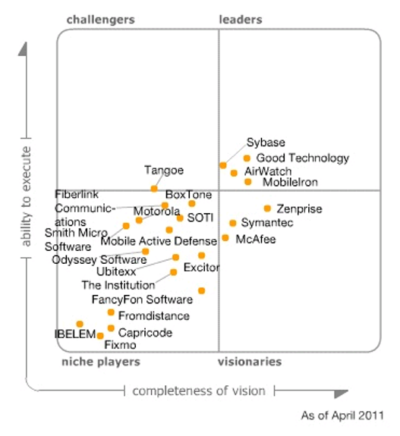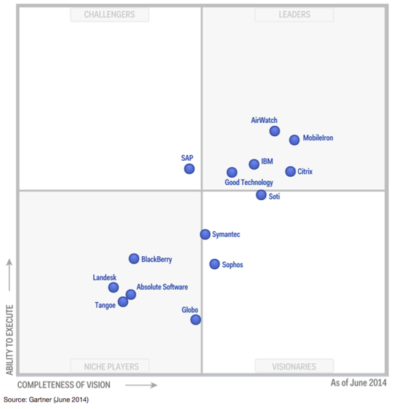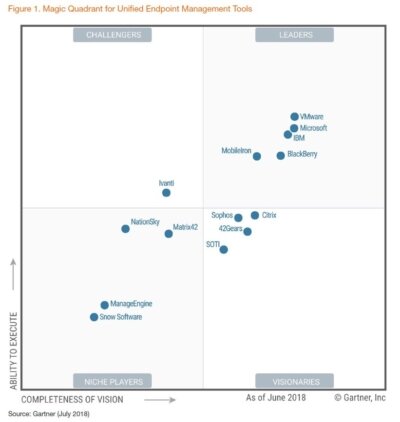It’s that time of year that we review the benchmark of where the world of mobility management, specifically Unified Endpoint Management (UEM), is at according to Gartner. I recently posted a similar article on LinkedIn reviewing the magic quadrant, but wanted to share my thoughts with everyone on the subject.
Mobile Device Management (MDM)
2011 was the start point of the mobile management industry with the release of the first Mobile Device Management magic quadrant. 23 vendors were selected from over 100 tracked companies doing some form of Mobile Device Management (MDM). There were 4 leaders in MobileIron, AirWatch, Good Technology and Sybase.
Gartner Magic Quadrant 2011

Enterprise Mobility Management (EMM)
Just 3 years later in 2014 Gartner decided to re benchmark the category to Enterprise Mobility Management Suites (EMM) due to the expansion of the use of the technology who had all moved into app and content management rather than just basic device management. This reduced the number of companies making the cut from 18 the year before to just 14. There were 5 leaders in MobileIron, AirWatch, IBM, Citrix and Good Technology. Of note of the 5 leaders IBM and Citrix had ‘purchased’ their way into the leaders quadrant with the acquisitions of Fiberlink and Zenprise who were both in the leaders quadrant in 2012 and 2013
Gartner Magic Quadrant – 2014

Unified Endpoint Management (UEM)
In 2018 once again we see that Gartner (and the market) has decided to re benchmark the category, this time to Unified Endpoint Management Tools (UEM). This is primarily due to the expansion of the number of OS’s the modern day management tool now supports. This has been largely driven by Windows 10 ‘modern management’ and moving forward will be driven by IoT.
In 2018, we still have 5 leaders:
-
VMware
-
Microsoft
-
IBM
-
Blackberry
-
MobileIron
Gartner Magic Quadrant – 2018

Of note is that 3 of the 5 leaders in VMware, BlackBerry and IBM have ‘purchased’ their way into the leaders quadrant with acquisitions of AirWatch, Good Technologies and Fiberlink. Only Microsoft and MobileIron have built out their offerings without acquisition. Also, this saw the first instance of Microsoft in the leaders quadrant with their work around Microsoft EM+S.
Where does the Unified Endpoint Management (UEM) go next? Is Microsoft’s new Modern Management poised to take over the industry?
Windows 10 Modern Management
Modern Management is a relatively new concept introduced by Microsoft within this space. Modern Management allows for Windows 10 to be managed like a smartphone. Modern Management replaces SCCM, Gold images and domain joined machines with cloud-enabled remotely managed endpoints with granular policies. Windows AutoPilot enables devices to be remotely configured as a seamless out of box experience in a similar manner to Apple’s Business Manager or Android’s Zero Touch.
Modern Management is the framework for cloud-first and mobile-first modern workforce. This creates an opportunity to dramatically improve the employee experience with provisioning, enrolling and managing Windows 10 devices. The implications for laptop and desktop management costs are equally dramatic with most research showing over 50% cost reduction on traditional Windows management.
Is Windows concept of Modern Management the next wave after Unified Endpoint Management?




